#ethical breeding
Note
When it comes to bonding and pairing behavior, how strong can some pairs be versus others? I have birds that are actively cheating on each other and others that fiercely defend each other and aren’t interested in other birds. I’m also wondering if how to split up biological siblings that have bonded and become mates
That's about the gamut. XD
Sexual fidelity has absolutely nothing to do with pigeon marriage.
What pigeons consider faithfulness from their partner is that they share the same roost at night, their mate gets first dibs when either bird wants sex, and they share both nesting and peep feeding duty equally.
As long as their partner is sated, they really don't care who their other half mounts or propositions.

Serket, for example, only has eyes for

Titan, his gigantic wife.
That exclusivity is mutual.
Titan has a fair few admirers!
Literally all the single boys want her and a few of the married boys will make a pass.

Sher will throw his little hat into the ring for anyone, despite being happily married to

Cotta's sister, Taffeta.

Sterling (single) used to be mated to Taffeta, but she left him for a cock whose family returned him.
After he went to a new family, she paired up with Sher, who has never had a mate.
Sterling makes passes at her and Titan about equally.

Ninka (single) was mated to Sage, the Chinese Owl, but as I opted to move away from that breed, I adopted her out.
Titan is his favorite hen to pursue, and he does it by kicking her husband out of any nest he tries to settle in.
Serket is tiny, so there isn't much he can do about it.

Orchid is obsessed with Titan and down right obnoxious about trying to shove Serket off of her and tread her while she's presenting.
There are SO many videos on my youtube and TikTok of Titan getting fed up with his bullshit and punching his face.
When that doesn't work, she bites the absolute fool out of him and snatches out neck feathers.
Serket and Titan are actually in the background of this photo, because I called Orchid's name to snap the shot mid harassment.
Serket is doing his absolute damnedest to body block Orchid from Titan.
You'll notice there are two very different sets of behaviors directed towards a Cock's wife and his side chick.
Wife gets the whole courtship ritual from dancing to chasing, to nest selection to kissing, and then she will present for him to tread.
Side chick just presents and he steps up on top of her, mounts her, and they're done: wham, bam, thank you ma'am.
A cock can have however many side chicks he wants, but usually only keeps one specific mate, whose nest he helps build, whose eggs he takes a turn setting, and whose chicks he helps feed and then teaches how to pigeon when they wean.
I have observed exactly one pigeon who I would classify as Polyamorous.

Ferdi had five wives!
Not a wife and four regular side chicks!
Five wives that he cycled through!
He'd be teaching the weaned peeps from one wife, helping feed a second's nestlings, taking his turn sitting the third's eggs, mating number four, and nest hunting/reaffirming with number five at any given time.
I retired him because I worried he was going to work himself to death!
Never seen another instance of it, but I have seen a whole range of sexualities and gender expression from pigeons.
But, yeah, what you're seeing in your flock is pretty normal.
Dad doesn't care who filled the eggs, as long as they are laid in his nest.
Mom doesn't care who else's eggs Dad fills, so long as he helps her hatch and raise hers.
Different individuals are different degrees of sexually faithful.
Makes keeping track of bloodlines a pain, but domestic animals are happiest when they can express natural behaviors.
Because of the way peeps tend to bond with in their age group, it's not uncommon for siblings to bond as mates if no other clutches hatch.
You have mentioned wanting to breed for companionship.
So in order to decide what to do about the two siblings, you need to consider which you are keeping and why.
Breeding is a selective process.
If you have all the pairs you need, you really only want to keep the *best* of their offspring.
Do you have any goal more specific than temperament?
With external traits, you'll have an idea of which to keep early on, if one or the other is an improvement in the desired traits over the parents.
But temperament is really hard to work out before the bird is fully mature.
That's one of those lessons I learned by experience. >.<
So, when the buildings are moved over, repaired, and ready for birds again, I will be keeping each pair's first clutch to evaluate for the first 6 months, and hatch controlling in the meantime.
When the peeps are fully developed, they will be evaluated against each other, and their parents.
Whichever offspring is an improvement over both parent's faults with a better temperament than the more skittish parent, that one will stay, the parents will be made available as a pair, and the sibling will be made available.
I hope to limit inbreeding this way, and prevent crowding.
If you just don't want offspring out of the siblings, hatch control as long as they are together.
Plastic or wooden eggs are your best friend!
28 notes
·
View notes
Text
When you talk about advocating for ethical breeding for multiple years and how it will help solve the homeless pet crisis and people will be better able to choose a dog that fits their home and your parents turn around and tell you they think you just don't like rescue and think nobody should rescue 🙃
SCREAMING
2 notes
·
View notes
Text

A beautifully colored pullet from this year. She’s from Clan B- my group with the poorest type. They’ve got extremely good health though, so I am working hard to make them show- worthy while retaining that good health.
19 notes
·
View notes
Text
I will say that I think ethical breeding as veered from "we should produce healthy, sound, stable animals from parents who are healthy, sound, and stable" to "anything not a purebred is inherently unethical and should not exist". I'm not sure how much of it is online virtue signaling, but enough of it is to make me roll my eyes.
Come on, y'all. I'm sure my health testing working mix is sooo much more unethical than your byb purebred Frenchie.
#dispatches#original content? on this blog?#discourse related#kiri rambles#kiri talks dogs#the last sentence is based on an actual facebook take#there is nothing wrong with a purebred#there is nothing wrong with a mixed breed#THE AIM SHOULD BE PRODUCING HEALTHY DOGS NOT PURITY POINTS#you will not convince me that a purebred Frenchie is better than my working herder sorry#ethical breeding#stop the virtue signaling
5 notes
·
View notes
Text
Just saw a post about cropping dog ears, so here are two other dog breeding practices that I think people should be more aware of. All these are abuse btw and do absolutely indicate backyard breeders. Also, I have experience with rough collies, so please correct me if I make mistakes and if something I say is only applicable to collies.
Number one: breeding two merled dogs together. The merled gene is an overlay, not a coat color. This means it’s a gene that goes on top of a regular color that makes the color look different. This is natural by itself and many dog breeds have this. Many people also think it looks prettier, and will go out of their way to buy merled dogs. This means that many breeders will breed two merled dogs together, to get more merled dogs. What’s abusive about this is that if a puppy happened to inherit the two merled genes, it will cause severe damage to the dog’s eyes and ears. Any good breeder knows this, so breeding two merles together anyway is abuse. This does NOT mean that any breeder that has merled puppies is abusive, but if both parents are merled, it is abuse. The picture below is of a merled collie btw (blue merle).
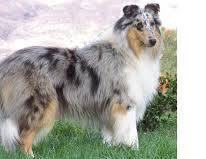
Number two: not doing genetic testing. Breeding dogs without knowing or considering what can be passed down to the puppies is abuse, and an unethical business practice. Unlike number one, buying from a breeder that doesn’t do genetic testing means that you can end up with an aggressive, sick, or severely impaired dog. This is also a good way to tell if you are buying from a puppy mill or not!
#Backyard breeding#Ethical breeding#Animal abuse#animal abuse tw#dogs#Bad breeding practices#Research before buying a dog!
2 notes
·
View notes
Text
adopt or shop responsibly
for this, any breeding I talk about is ethical breeding and leaving out BYB dogs - that's a topic for a different day
breeding dogs preserves ancient breeds and improves new ones
breeding gives us reliable working dogs, don't expect a shelter dog to do good work
most dogs that come from shelters will be mixed and when your mixing breeds, your mixing temperaments and not everyone wants that
ethical breeders have contracts saying if the dog is unwanted or it doesn't work out that you need to bring the dog back, an ethical breeder will always take the dog back and do not contribute to shelter population
3 notes
·
View notes
Text
Springing off of @darkwood-sleddog's post I just reblogged because I'm narrowing down into a specific breed and the trends I've noticed lately:
Xolos are not for a first time dog owner, generally speaking, unless you grew up with primitive breeds or are willing to do the work. Because of being a primitive breed they come with some challenges such as being less biddable. (Biddable meaning eager to please, NOT less trainable.) Because they're less biddable, I have seen a number of people being told by trainers that their xolo isn't worth training because they're just unintelligent dogs. Aka the dog doesn't listen to their methods so the dog must be dumb. I've seen this reported from almost a dozen Xolos owners who have been understandably distressed to hear this from a "dog professional".
Xolos are wickedly trainable but you have to partner with the dog. They don't listen just because they want to make you happy. If you build a bond with them you can actually help them become more biddable because of that bond - but you still need to realize they are a dog who will work for payment and fair treatment. If you can't manage that, you will have a difficult time. And trainers who only work with highly biddable breeds will find them difficult and this in turn gives xolos a poor reputation and some trainers will not even try with them.
Another issue I've seen is how many new owners are having issues with people aggressive xolos. As a general rule, xolos are aloof and tend to be more cautious dogs. Good socialization can cure a lot of this. But even with the base nature being shy, correct xolo temperament isn't aggressive. They generally will shrink away, flee, or withdraw - not bite at people. People just breeding any two xolos are leading to severe temperament issues just like with malamutes like darkwood mentions in their post. And this uptick in temperament issues is causing new owners a lot of issues combined with some trainers already predisposed to thinking xolos are just dumb dogs to start with. They can't get the help they need although chances are, a lot of these people shouldn't have gotten a xolo in the first place and their inability to handle the base nature is worsening the expression of poor temperaments.
And another big issue that's coming up a lot lately is people crossing xolos to other breeds in the hopes to make hairless versions of the other breed and this is not being done with any purpose in picking parentage at all. These are just randombred pairings to try and make hairless French Bulldogs and hairless versions of other trendy cute breeds. Which wouldn't be the most awful thing if people were doing good husbandry practices and taking parent health and temperament into play but they aren't. At all. It's just a cash grab leading to poorly bred dogs that won't have a high chance of good temperament or health.
#xoloitzcuintli#xoloitzcuintle#xolo dog#xolodog#mexican hairless dog#ethical breeding#ethical dog breeding
17 notes
·
View notes
Text
#african grey lifespan#african grey parrot#african grey parrot lifespan in captivity#african grey parrot care#cute birds#african grey parrot website#african grey behavior#african grey#buying an african grey parrot#african grey parrot buy#african grey life#African grey lifespan#African Grey Parrot#African Grey Parrot Price#african grey website#beginner parrot care#bird care#bird enthusiasts#bird health#bird lovers#conservation efforts#ethical breeding#happy parrot#healthy parrot#how long does african grey live#online pet forum#parrot accessories#parrot adoption#parrot advice#parrot behavior
0 notes
Text
Lykoi the werewolf cat breed
So I’m not going to be arguing because I’ve seen enough from enough owners over the years to have reached this conclusion, and I’m not in well enough health to come back to this. But I’m seeing the lykoi breed get more attention around tumblr lately, and I’ve gotta speak up because the breed has a dirty little secret.
I joined the Lykoi Lovers group years ago because I loved this breed, they’re super cute! I love werewolves! However, over the years, as more people got these cats, and their cats aged up (3-5+yo is when skin issues become REALLY evident) the group turned into a horror show.
This mutation really reminds me of lemon frost in leopard geckos. In the geckos, it was the desirable appearance which CAUSED the cancerous tumors. It wasn’t something that could be bred out. Similarly, it is the werewolf appearance which causes the skin issues, cysts, pimples, bleeding in the cats. You can breed away from it... and end up with a normal looking cat with fewer skin issues. You cannot seem to keep the werewolf look AND have good skin.
More below, and it IS graphic so be warned. Pus, blood, sad cats under the cut.
Let’s start with "what to know before getting a Lykoi”


Okay, inevitably bumpy? What’s that mean exactly?
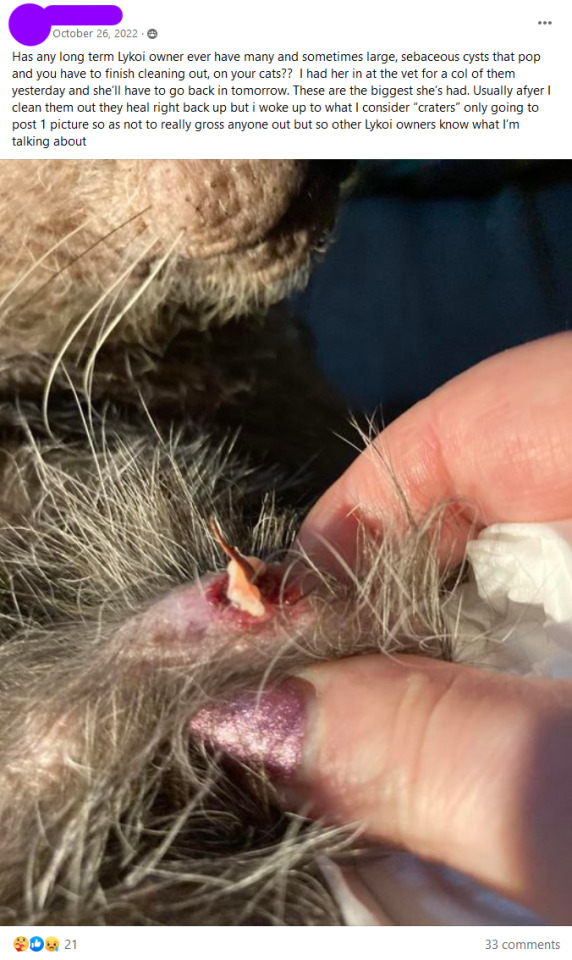
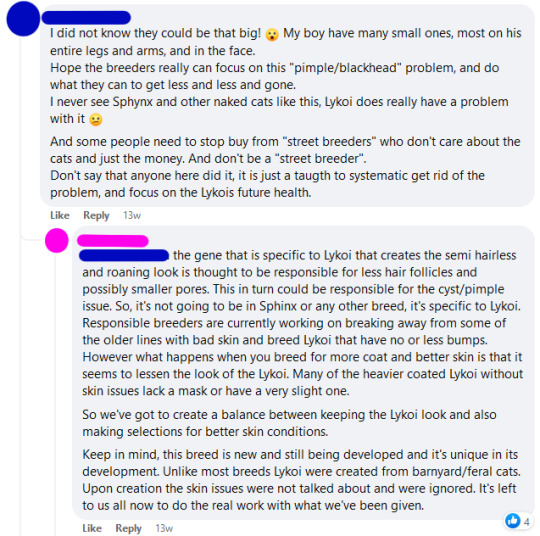
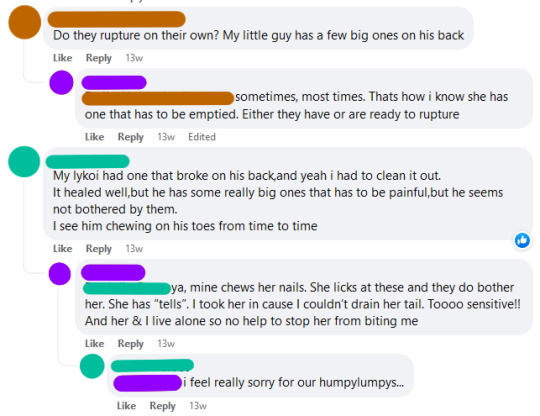
“The gene that is specific to Lykoi that creates the semi hairless and roaning look is thought to be responsible for less hair follicles and possibly smaller pores. This in turn could be responsible for the cyst/pimple issue. So, it's not going to be in Sphinx or any other breed, it's specific to Lykoi. Responsible breeders are currently working on breaking away from some of the older lines with bad skin and breed Lykoi that have no or less bumps. However what happens when you breed for more coat and better skin is that it seems to lessen the look of the Lykoi. Many of the heavier coated Lykoi without skin issues lack a mask or have a very slight one.“
^^^This is pretty damning as far as the future of the breed goes. Well bred ones will not look like werewolf cats.
Okay, but that’s just a couple cats, and just one cyst. That’s not so bad---

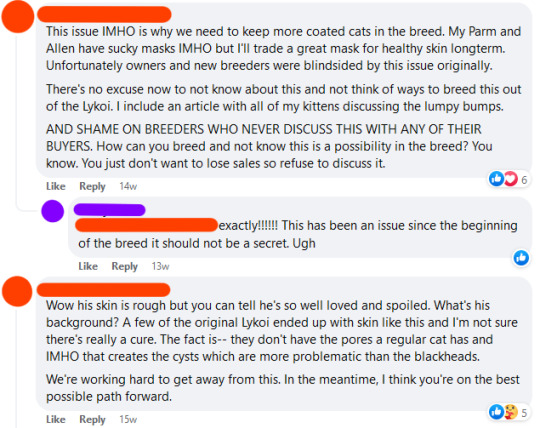

“They definitely bother me more than her.” You sure about that?? Look at her...

Okay but that’s just a FEW cats, how bad could it b--
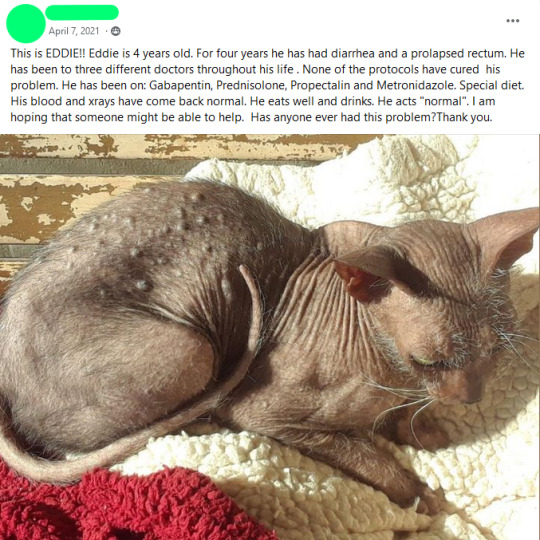

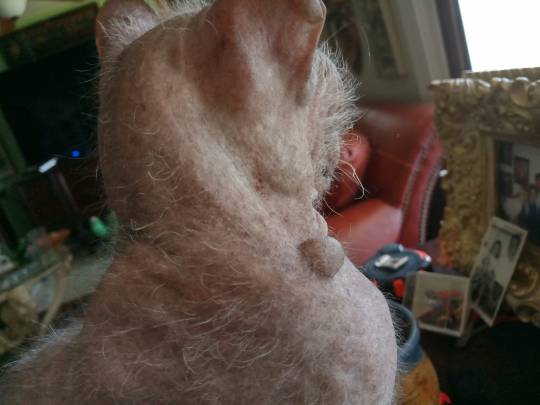
Again, this issue typically appears after the cat is 3-5 years old, so people buy their little werewolf cats unwise to the fact it’ll live with painful skin problems for the majority of its life.
It is the very mutation which reduces follicle count and pore size which causes the werewolf appearance and the blackheads and cysts, so I think “breeding it out” is nothing but a pipe dream. The mutation itself is what causes the problems, as mentioned earlier just like lemon frost leopard geckos.
Anyway, this has been a PSA.
#animal ethics#lykoi#cat#psa#animal cruelty#torture breeding#so many harmful mutations where people think you can keep the appearance but not the negative parts... it often does not pan out#and given the evidence i don't think it will here#for decades people tried breeding the neuro out of spider ball pythons etc#instead we just ended up with a million neuro-affected spider ball pythons good job everyone
5K notes
·
View notes
Note
https://vm.tiktok.com/ZMYkXyCKp/
Hey what’s ur opinion on silkie/frizzles? Is that like, healthy?
From what I have experienced, there is nothing wrong with a bird that simply has the silkied or frizzled feather types. I’ve never had an issue with my birds. Some of the strongest in my flock are frizzles and silkies.
Sizzles, when a bird is both frizzled and silkied, do exist, but they take a couple generations to achieve. The chicks in the video aren’t sizzles. Silkie is a recessive allele, so that means that while those chicks could produce sizzle chicks in the future, they themselves do not have silkied feathers. I’ve never had a sizzle but I don’t think there’s anything wrong with them, either.
As an actual breed, a lot of silkies are overbred and unhealthy, but from appearances I’m not worried about the birds in the video. She very well could be carrying something nasty (the silkie breed is prone to vitamin deficiency, for example, and you can’t tell that from type) but the owners wouldn’t know that without breeding her. She doesn’t have excessive foot feathering, a massive crest, or a beard and muffs that disrupt her vision.
I don’t see anything wrong with these folks mix breeding their pets. :). The chicks are cute and look well cared for. I don’t have TikTok downloaded atm so I can’t tell you about the rest of their account to get a better picture, though.
#chickenblr#birblr#serama#farmblr#chicken breeding#ethical breeding#silkie#frizzle#sizzle#chickens#asks
8 notes
·
View notes
Text

Drew a raspberry ranchu 'cause I like their blobby heads 💗
Third fish-themed piece in a row 🥰 ! I blame the weather for being TOO HOT ALL SUMMER
#ranchu goldfish#goldfish#raspberry#cottagecore#fishblr#art#goldfish art#elbarklaart#cute#i dunno about the ethics of selectively breeding these guys but they're still cute ok
255 notes
·
View notes
Text
i know i don't talk much about my pets (who aren't leon) here but after keeping reptiles and amphibians for a decade i might finally get into breeding them and i'm so excited!!
#the market was so oversaturated when i got into the hobby#but they banned private pet sales in austria a few years ago and it absolutely destroyed the hobby breeding communities which tend to have#the best quality and most ethically bred animals. so now it's mostly pet stores selling badly bred animals or imports from large scale#rack breeders in germany or other European countries where racks aren't illegal yet#but yeah i'm already a registered business and it's not much extra paperwork to register as a breeder and do it all with proper paperwork!
65 notes
·
View notes
Note
Sorry about the color mix up. I appreciate the reply and additional info! I guess bc I know nothing about peafowl (and the fact i dont breed any type of animal), I'm having a hard time understanding how being sterile would be unethical. I do somewhat get the shortened life span. I really would like to understand this, I just sometimes need stuff explained like I'm 5.
Up front, there's no "somewhat get" to a shortened lifespan being caused by a mutation in captive populations. If an animal is capable of living 20+ years (and some live 30+ or even 40+!) and some non-essential mutation is causing them to live 7-9 years, it's flat out absolutely unethical to breed that mutation, full stop, regardless of anything else going on. That's indicative of a MAJOR problem in their genetics. There's NO ethical reason to breed that because humans like how it looks. So, even without the sterility, these birds would 100% be unethical to produce.
The short answer on sterility is this: we don't know WHY they are sterile, but they shouldn't be, and that means something has gone wrong. When something goes wrong with an animal, and it's something genetic that can be passed on, the ONLY responsible and ethical thing for a breeder to do is to stop using that animal for breeding and closely monitor any already-produced offspring for signs of the problem, and likely not breed them, either.
The longer more complicated answer is this: sometimes it's possible to separate the problem from the aesthetic when it comes to morphs, like it was for cameo + blindness, but sometimes it's NOT, like it wasn't for spider + head wobble for ball pythons. In those instances, it's... difficult. Because you're LIKELY going to produce animals that suffer the same problem as their parent(s), in the attempt to separate the problem from the aesthetic, and sometimes that's ALL you're going to produce. As a breeder, it's your absolute responsibility to NOT release the offspring into the general population, where the problem may be replicated without control, and to keep or cull the affected individuals if the problem cannot be separated from the aesthetic, or AT BEST find them guaranteed pet-only homes that will NEVER breed them.
Sometimes the problem IS purely aesthetic or harmless, like it was for pied in peafowl, and sometimes it's not, like it was for vitiligo in peafowl. The problem comes when you ASSUME a mutation is the first, and treat it like the first when it's really the second. This has caused FAR reaching consequences in the peafowl community, and I'm sure in others, where now the autoimmune disease that first bronze had has been passed into genpop by folks who thought they were breeding a harmless new variation of pied. Hybrid animals are often sterile (not in peafowl though, hybrid cristatus-muticus birds are fertile) because of a mismatch in chromosome pairing numbers, and often that's harmless. So, in some cases sterility is not an issue because it's the expected result or is otherwise harmless... but in the case of peafowl, it's NOT an expected result and we don't know if it's caused by something harmless or not.
Some species, like mice and horses and cattle and dogs, genetic testing and DNA mapping done with millions of dollars has proven that while some stuff isn't purely aesthetic, it also doesn't cause harm to the animal in a way that affects quality of life or that can be adapted for in captive care. For example, in chickens, the frizzle gene causes curled feathers in single copy and an absence of feathers in double copy. This gene is considered ethical to produce IF the breeding is done responsibly by putting a single copy bird over a zero copy bird, which produces smooth coats and frizzle coats, but it is unethical to produce double frizzles (called "frazzles") because frazzles cannot thermoregulate, can easily sunburn, and easily suffer skin injury during normal chicken activity.
For peafowl, we have NO genetic testing. We do not have the genome mapped. As far as I know there's a research group working on it (mostly for green peafowl though, in conservation efforts), but that's not remotely finished or available to the public to test anything. We don't know where any of the morph mutations sit, or what is causing them or if they do anything beyond just change the color. Sometimes color mutations are the result of malfunctions in enzymes. For charcoal specifically, we don't know what the mutation does, besides what we can observe on the outside- the birds have half or less the lifespan of normal birds, poor feather quality, and the hens are sterile. Is the sterility harmless like it is in some hybrid animals, or is it actually a major organ failing? Is it the only major organ that fails due to this mutation, or is it just the first sign of their shortened lives? Is it some deficiency in something the birds need to be healthy? Does it hurt the bird? We don't know, but we do know the mutation and the problems (multiple, please do NOT forget that this is one OF MORE THAN ONE problems) can't be separated, and so until we do know why and whether it's harmless or not, the ONLY ethical response to seeing a problem in a major organ's function linked inextricably to a mutation in color is to not propagate that mutation. If someone wanted to fork over the millions it takes to sequence and map genomes and then determine exactly what is going on with peafowl, that would be nice and good, but I don't see that happening. When I win the lottery big, I'll be doing it, but til then we can only follow normal breeding guidelines
Also, to put this into perspective... peafowl mature sexually around 3 years old. They are chicks until the turn of the new year following their hatch. They are yearlings that year, and immature 2yo next year. They aren't actually considered fully grown until 6 years old, and should live another 14+ years. Charcoal birds die a 1-3 years after full maturity. Is it a coincidence that they fail to thrive shortly after full sexual maturity, or is it linked? Again, we don't know. We don't know if the sterility is fine or if it's just a symptom of something worse.
Even without the sterility, though, charcoal has enough issues it would be unethical. If it was JUST sterility, with no other deleterious effects, then maybe it would be different. But it's not.
#peafowl#asks#anon asks#as always please bear in mind that animal breeding is NOT the same as human reproduction ethics#and I ONLY deal in animal ethics#and honestly even if it was just shit feather quality then I would personally consider it bad breeding#I asked the only person I know who still has charcoals what their issues were and lord it is worse than I thought even#she's keeping/breeding only what she can keep herself#and experimenting with feeding regimens in the hopes of correcting a nutritional deficiency#that might account for the sterility#but so far after like 10+ years she's had no luck#so it's not likely#Like there are SO MANY perfectly fine and healthy morphs out there#there's NO reason to keep making this one#it's not essential to the continuance of the species#also to anon: I'm not mad at all this is just how i sound about my special interest#I'm glad you asked questions#I appreciate you seeking info
109 notes
·
View notes
Note
Question: Since the mutation that makes sphynx cats nakey (their hair is fragile and sucks) can just happen at random. How would a Clan treat a nakey cat born among them? Could they make them a coat?
I think, at first, there would be concern that it's some kind of sign. Hairlessness looks like mange, a very serious and contagious condition. This could be a terrible omen-- that mange will be brought down to us.
But it would become apparent the kitten isn't a fader, it isn't a StarClan warrior who came down to deliver the others, or a mere sign. It's pink and wrinkled, like a newborn rodent, but moves as the other kits do. Did StarClan... forget its fur?
There's another feared creature without any fur-- humans. It looks human.
I think the poor thing would have a lot of problems with the other cats its age and maybe the more superstitious members of the Clan, but a warrior of the Clan is a warrior of the Clan. Life would be harder for them, but there would still be love that exists.
They'd be capable of making them a coat, and they WOULD need it, but I can see that cat trying to go without it for fear of being made fun of. That's another thing humans do-- wear pelts all over themselves because they have no fur of their own.
Unfortunately they'd also be prone to a ton of really bad health problems. This poor guy would be in the Cleric's den a lot, and may need to retire early or focus on campbound activities.
Health problems;
Pelt is a LOT weaker; injuries from battle or even training would be a lot more severe, Cleric may recommend them not taking part in fights.
Skin becomes filthy, and needs special cleaning. There is no fur to absorb the oil that the skin naturally makes to keep the coat healthy, causing buildup.
Even with proper cleaning, the skin is super prone to rashes, lesions, and constant irritation. Wash TOO MUCH and the skin will become dry and chapped.
SUNBURN. Especially in WindClan, where the warrior might spend a lot of time on the open moor in daylight, and RiverClan, where light reflecting off the water could cause an intense burn. It would be recommended the warrior take night shifts, but this could be an issue because night is cold. (BB!Cats are crepuscular).
Additionally; such severe, uniquely-placed sunburns are something Clerics wouldn't see very often. Lack of medical experience with these sorts of injuries could prove dangerous.
Ear infections. Cats naturally have hair in their ears, which their earwax production accounts for.
Both heatstroke AND frostbite. Very bad temperature regulation leading to severe ailments. Fur helps stabilize body temperature.
So in conclusion...
Life would be very difficult for this individual. Fur isn't just full-body hair; it's almost as fundamental as a top layer of skin. This would be a serious disability for a Clan cat to have, and it may invoke the image of detested humans leading to social stigmatization.
But because they're clanborn, they are unambiguously a member of the Clan. It's likely that the Clan would make clothing for this warrior out of fur pelts, but in their struggle with internalized ableism, they might have conflicted feelings about wearing it.
The Cleric would recommend campbound activities, night shifts, and WEARING YOUR PELT, DAMN IT. They would need to take full baths every few days, not too much and not too little, plus frequent ear cleanings.
#Clan culture#Hairless cat#Disability#for the record. Im not pro-sphinx breeding. I think that's obvious but... I don't think this is ethical.#They can live full lives with extra proper care but I don't think this is just a cute trait that's ok to select for#we shouldn't intentionally breed animals that produce oil for fur we've altered out of them#And they're so prone to rashes and lesions and wax buildup...#There's WORSE breeds but that's also not okay.#they are also not hypoallergenic. Common misconception. They will still bother your allergies if you are allergic to cats.#Because the allergen is the OIL AND DANDER#Not just fur broadly#BUT an animal born this way still deserves sympathy and a full life#and Clan cats always care ferociously for their own.#So if it popped up as a mutation they would be cared for#But if they had the chance to become a kittypet... that might actually really be their best option#Or a daylight warrior even!
215 notes
·
View notes
Text
publicly kissing @meebles on the forehead for being extremely lovely about the inevitable byproduct of cowriting a dinosaur cowboy au with someone for whom dinosaurs are a special interest
#ask me how many hours i spent today researching hadrosaurs. just bc she asked me about including them bc they're cute (and they are)#and i immediately went down the rabbithole on how big the different ones were and thinking about the logistics of supporting a herd of them#and how many messages i sent her about it once i figured it out#or actually dont ask 😂😂#i also took 30 minutes to answer a question on the possibility of baby dinos in the context we'd been talking about#and then went off on a tangent on the ethics of breeding de-exctincted animals 😂😂
21 notes
·
View notes
Text

"A lot of people think cropping dogs ears is unnecessary, but please consider this argument: It looks dope as fuck."
#i am against cropping#but this made me laugh#and i mean#dude's not wrong#sorry some breeds look cool with cropped ears#RIP to ethics#this isnt the only argument made in the whole paper#its just the funniest one to include in the abstract this way
29 notes
·
View notes